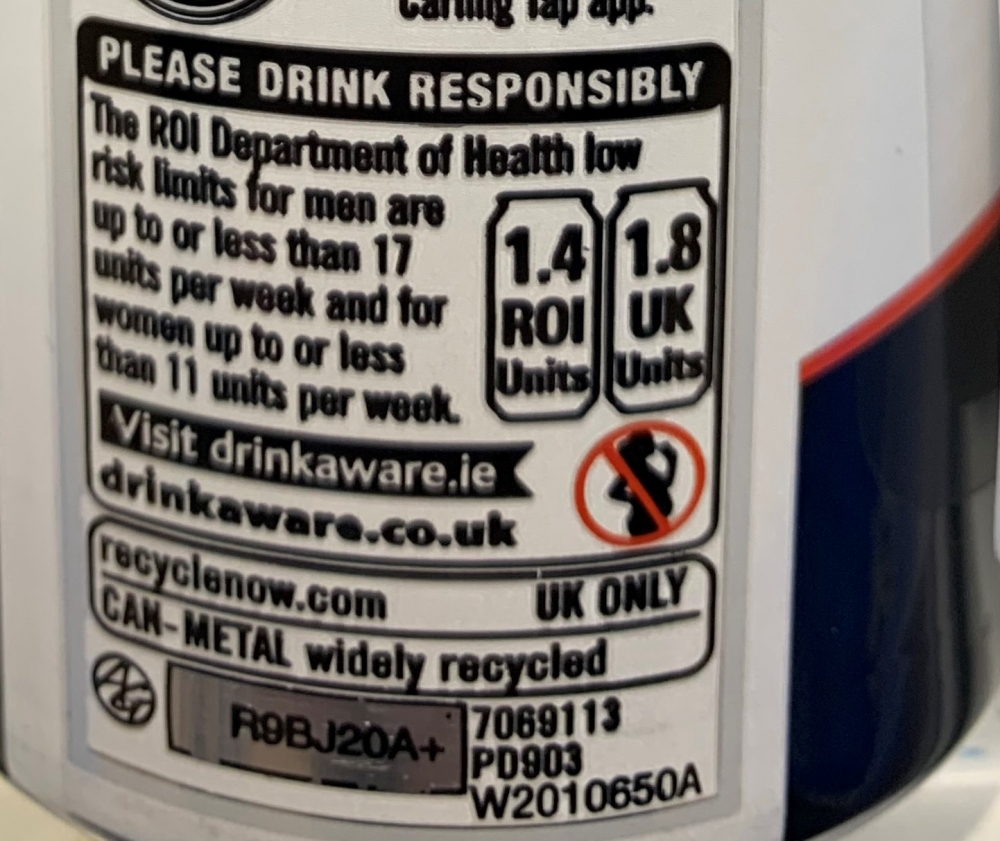New survey shows drinkers being kept in the dark
Drinkers are being kept in the dark about how to minimise the risks from alcohol as a major survey shows producers are failing to include basic health and calorie information on labels.
And the drinks giants who fund the industry’s self-styled ‘social responsibility’ organisation – the Portman Group – are the worst offenders.
The call for more clarity comes from Balance as a new report by the Alcohol Health Alliance (AHA) found more than seven in 10 alcohol products on UK shelves fail to display the Chief Medical Officer’s official “low risk” guidelines of no more than 14 units a week.
Astonishingly, the law only requires drink labels to include strength (ABV) and volume. That means vital information like the low risk drinking guidelines, health risks, calories and ingredients are only included voluntarily, despite alcohol being a class 1 carcinogen. This is in stark contrast to the labelling requirements for all other food and drink products.
In July, the Government announced it will launch this year a consultation on including calories on alcohol by law, which Balance has welcomed as a first step.
The alcohol industry claims self-regulation is working and agreed to update labels to display the CMO weekly guidelines by September 2019. However, the survey of 424 alcohol products across the UK shows:
- More than 70% of labels failed to include Chief Medical Officer drinking guidelines of no more than 14 units a week – over three years after they were updated and well after the deadline by the Government.
- Though the industry-funded Portman Group calls itself the alcohol industry’s “social responsibility body” and “leader in best practice”, Portman Group members were LEAST likely to provide health information voluntarily. 98% of Portman Group funders’ big-name labels reviewed in this study failed to include the correct drinking guidelines.
- More than half (56%) of labels included no nutritional information. 37% of labels listed only the calorie content of the container, and just 7% displayed a full nutritional information table.
- Incredibly, nearly a quarter of labels surveyed contained misleading, out-of-date health information, such as the old UK guidelines or guidelines from other countries.
- Health information was often hard to read, with average height only 2mm high and well under the 3.5mm required to be easily readable.
Colin Shevills, Director of Balance, said: “This report is just the latest in a long line which shows that alcohol producers have been breaking their promises on alcohol labelling for the last two decades. People have a right to know what is in the drinks they consume, but the findings of this investigation show that alcohol companies are not just still dragging their feet but also displaying potentially harmful advice.
“Post COVID, it is important that now more than ever we enable people to look after their health, and not drinking too much is part of staying fit, healthy and resilient. However, there is still some way to go before the public will see labels which enable them to make fully informed decisions about consumption. Alcohol is linked to a wide range of medical conditions, including seven types of cancer, heart disease and strokes.
“Most people in the North East back compulsory health labels on alcohol. But as it stands, the law requires more information to be displayed on a pint of milk than on a bottle of wine.”
Professor Sir Ian Gilmore, Chair of the Alcohol Health Alliance UK, said: “Alcohol labelling in this country is woefully inadequate and not fit for purpose if we wish to build a healthier, resilient society post-COVID-19. It is disappointing but telling that members of the Portman Group – the body purporting to promote “best practice” on labelling of alcohol products – are the least likely to display basic health information and it is time that mandatory labelling is introduced.
“The public must be granted the power to make informed decisions about their health by having access to prominent health warnings, information on ingredients, nutrition and alcohol content at the point of purchase. The industry’s reluctance to include this sort of information on their products suggests profits are being put ahead of people’s health.”
A 2019 survey of the general public found the majority of people in the North East believe more information on alcohol labels should be a legal requirement:
- 62% supported calorie information
- 56% supported weekly low risk drinking guidelines
- 71% supported a general warning that exceeding the guidelines can damage health
- 68% supported a specific warning that alcohol is a cause of cancer
In their 2018 Alcohol Framework the Scottish Government committed to consider pursuing mandatory approach to labelling in Scotland if alcohol producers did not include the low-risk drinking guidelines on products by the UK Government’s deadline of September 2019. We’re nearly a year on from this deadline and this research clearly demonstrates that the industry won’t make these changes voluntarily.
A Canadian study released in May found that alcohol warning labels, like warnings on packets of cigarettes, are effective tools in helping drinkers make informed decisions. The study found consumers exposed to the labels were 10% more likely to know about the link between alcohol and cancer and three times more likely to be aware of the low-risk drinking guidelines.
